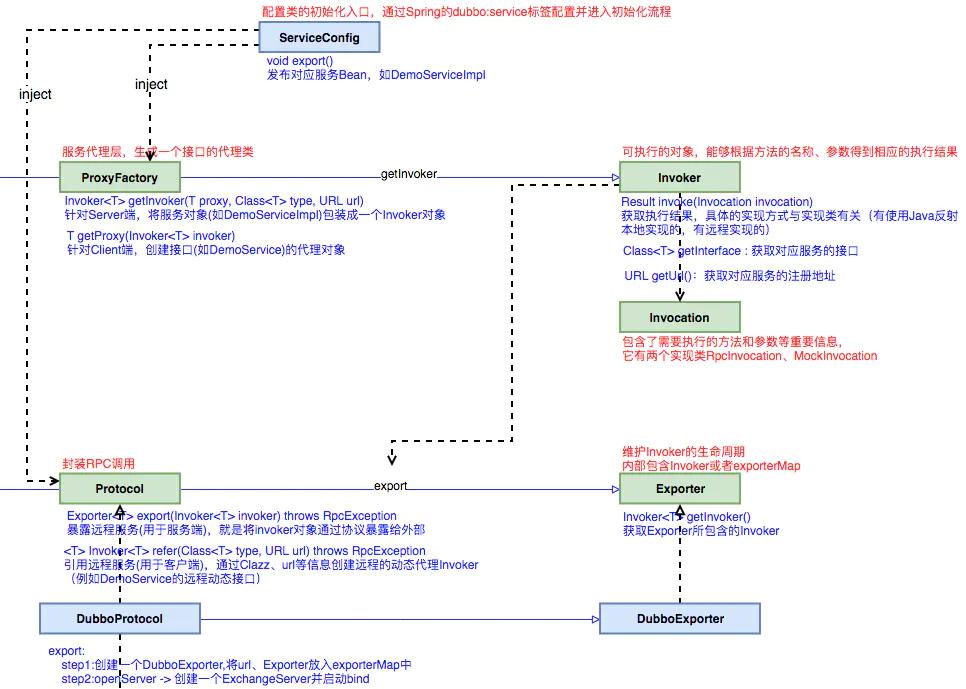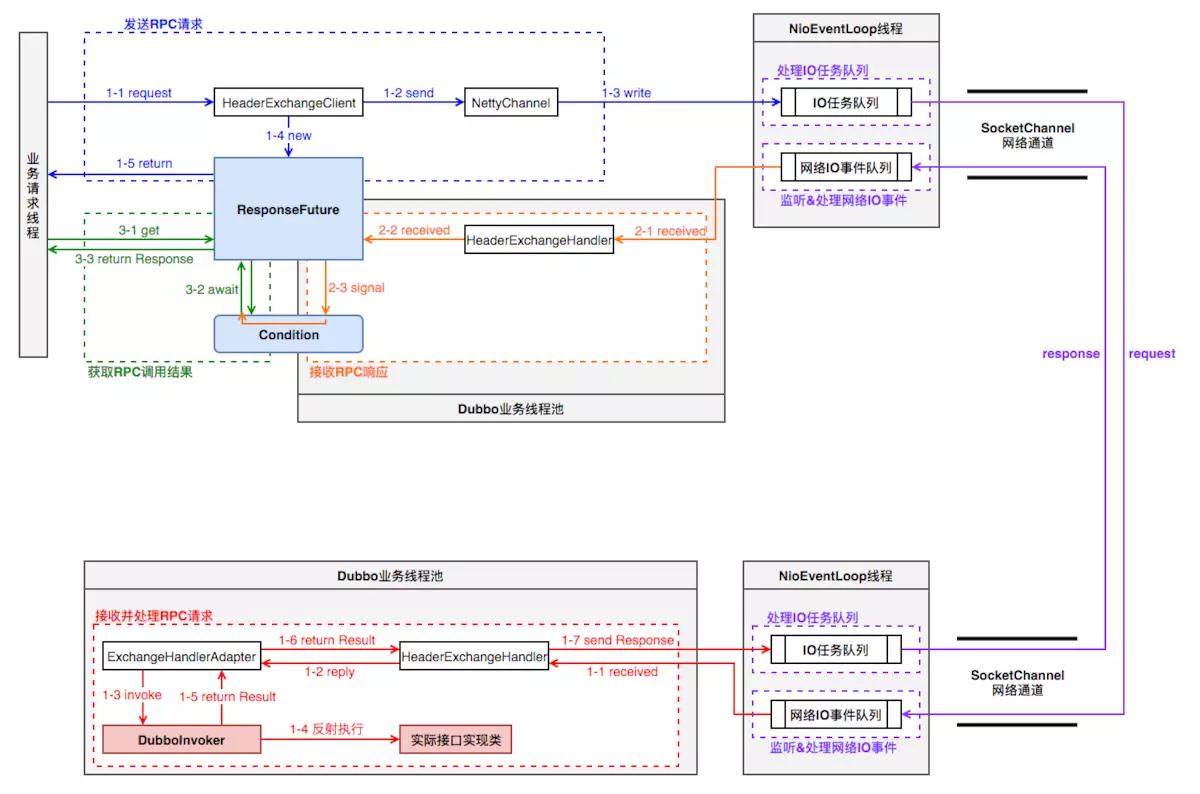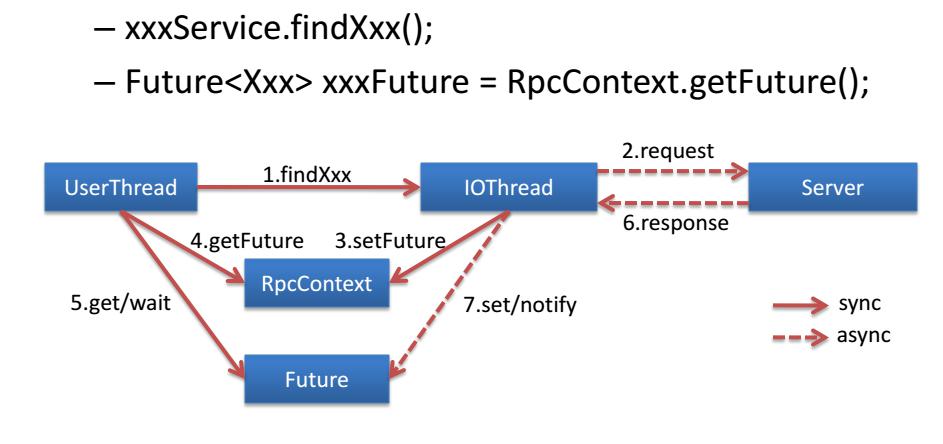dubbo使用简单介绍与启动流程以及请求响应流程
一、使用
1、服务端
Dubbo配置:
@Configuration
public class DubboConfiguration {
@Value("${dubbo.protocol.port}")
private int port;
@Value("${server.port}")
private String httpGateWayPort;
//
@Bean
public ApplicationConfig applicationConfig() {
ApplicationConfig applicationConfig = new ApplicationConfig();
applicationConfig.setName("nacos-provider-test");
applicationConfig.setRegistry(registryConfig());
return applicationConfig;
}
@Bean
public RegistryConfig registryConfig() {
RegistryConfig registryConfig = new RegistryConfig();
registryConfig.setAddress("nacos://127.0.0.1:80");
// registryConfig.setAddress("zookeeper://127.0.0.1:2181");
return registryConfig;
}
@Bean
public ProtocolConfig protocolConfig() {
ProtocolConfig protocolConfig = new ProtocolConfig();
protocolConfig.setPort(port);
protocolConfig.setTransporter("netty4");
protocolConfig.setThreadpool("fixed");
protocolConfig.setThreads(500);
return protocolConfig;
}
@Bean
public GateWayProcessor gateWayProcessor() {
return new GateWayProcessor(String.valueOf(port));
}
}
配置定义了应用配置,注册中心,协议配置等。
暴露服务:
@Service(interfaceClass = BankStatmentService.class,version = "1.0.0")
public class BankStatmentServiceImpl implements BankStatmentService {
}通过上述的配置和定义,springboot启动后,Dubbo服务也会启动,并注册到nacos注册中心。
二、启动流程介绍
其实在之前的一篇文章,有过简单的介绍: Java的NIO及Netty
dubbo和spring整合可以通过XML配置和注解两种方式实现。
XML属于传统的spring配置方法,在spring中由一种机制叫做XML扩展机制Schema,用于定义和配置 Bean。 它允许开发者自定义 XML bean 解析器,并将解析器本身以及最终定义的 Bean 集成到 Spring IOC 容器中。
Dubbo实现了spring 的NamespaceHandler接口:DubboNamespaceHandler。该接口的初始化方法:
public void init() {
this.registerBeanDefinitionParser("application", new DubboBeanDefinitionParser(ApplicationConfig.class, true));
this.registerBeanDefinitionParser("module", new DubboBeanDefinitionParser(ModuleConfig.class, true));
this.registerBeanDefinitionParser("registry", new DubboBeanDefinitionParser(RegistryConfig.class, true));
this.registerBeanDefinitionParser("monitor", new DubboBeanDefinitionParser(MonitorConfig.class, true));
this.registerBeanDefinitionParser("provider", new DubboBeanDefinitionParser(ProviderConfig.class, true));
this.registerBeanDefinitionParser("consumer", new DubboBeanDefinitionParser(ConsumerConfig.class, true));
this.registerBeanDefinitionParser("protocol", new DubboBeanDefinitionParser(ProtocolConfig.class, true));
this.registerBeanDefinitionParser("service", new DubboBeanDefinitionParser(ServiceBean.class, true));
this.registerBeanDefinitionParser("reference", new DubboBeanDefinitionParser(ReferenceBean.class, false));
this.registerBeanDefinitionParser("annotation", new AnnotationBeanDefinitionParser());
}另外一种方式是注解方式,也是目前springboot中多数采用的一种,@Service,@Reference。对应的处理器是ServiceAnnotationBeanPostProcessor和ReferenceAnnotationBeanPostProcessor。其主要目的都是生成对应的Bean。
先看下服务端(都说注解方式的):
@Service(interfaceClass = GoodService.class,version = "1.0.0")
整体流程:
1、根据注解,Dubbo会创建Bean;
2、根据事件监听机制,触发实例化的ServiceBean暴露服务;
3、向注册中心注册服务;
现在具体说一下服务启动流程(dubbo:2.7.3)。
1、serviceBean的初始化
spring在初始化的过程中会在实例化Bean前、实例化之后等各个流程中执行一些processor,主要目的是实现一些自定义的特性。ServiceAnnotationBeanPostProcessor实现了BeanDefinitionRegistryPostProcessor。具体spring容器启动流程可参考: https://blog.csdn.net/qq_35190492/article/details/110383213
ServiceAnnotationBeanPostProcessor的postProcessBeanDefinitionRegistry方法负责注册所有的Servicebean,即使用service注解的。它会扫描指定的package。在应用中可以指定:
@EnableDubbo(scanBasePackages = "com.hbnnmall.hbnnmallproduct.service")
部分注册Bean的代码:
private void registerServiceBeans(Set<String> packagesToScan, BeanDefinitionRegistry registry) {
DubboClassPathBeanDefinitionScanner scanner =
new DubboClassPathBeanDefinitionScanner(registry, environment, resourceLoader);
BeanNameGenerator beanNameGenerator = resolveBeanNameGenerator(registry);
scanner.setBeanNameGenerator(beanNameGenerator);
//添加了Service注解过滤器
scanner.addIncludeFilter(new AnnotationTypeFilter(Service.class));
/**
* Add the compatibility for legacy Dubbo's @Service
*
* The issue : https://github.com/apache/dubbo/issues/4330
* @since 2.7.3
*/
scanner.addIncludeFilter(new AnnotationTypeFilter(com.alibaba.dubbo.config.annotation.Service.class));
for (String packageToScan : packagesToScan) {
......
}
}
2、Dubbo服务的启动
ServiceBean是继承InitializingBean, DisposableBean, ApplicationContextAware, ApplicationListener等。其中ApplicationListener就是一种事件机制,其中有个onApplicationEvent方法,就是dubbo服务启动的入口,实例化之后springboot会向所有的listener发布事件。通过打段点,debug可发现,触发该方法的是:
org.springframework.context.event.ContextRefreshedEvent,目前spring存在的事件包括:
- ContextRefreshedEvent:Spring应用上下文就绪事件;
- ContextStartedEvent: Spring应用上下文启动事件;
- ContextStopedEvent: Spring应用上下文停止事件;
- ContextClosedEvent: Spring应用上下文关闭事件;
public void onApplicationEvent(ContextRefreshedEvent event) {
if (!this.isExported() && !this.isUnexported()) {
if (logger.isInfoEnabled()) {
logger.info("The service ready on spring started. service: " + this.getInterface());
}
this.export();
}
}上述方法直接调用的是ServiceConfig的export方法,主要是服务暴露的流程。
先来一张服务的整体流程示意图(来自网络):

public synchronized void export(ClassLoader classLoader) {
if (this.provider != null) {
if (this.export == null) {
this.export = this.provider.getExport();
}
if (this.delay == null) {
this.delay = this.provider.getDelay();
}
}
if (this.export == null || this.export) {
if (this.delay != null && this.delay > 0) {
delayExportExecutor.schedule(this::doExport, (long)this.delay, TimeUnit.MILLISECONDS);
} else {
this.doExport2(classLoader);
}
}
}首先是各种环境配置检测。
completeCompoundConfigs();
// Config Center should always being started first.
startConfigCenter();
checkDefault();
checkProtocol();
checkApplication();
// if protocol is not injvm checkRegistry
if (!isOnlyInJvm()) {
checkRegistry();
}
this.refresh();
checkMetadataReport();doExportUtls会根据protocols循环调用doExportUrlsFor1Protocol()方法。
private void doExportUrls() {
List<URL> registryURLs = loadRegistries(true);
for (ProtocolConfig protocolConfig : protocols) {
String pathKey = URL.buildKey(getContextPath(protocolConfig).map(p -> p + "/" + path).orElse(path), group, version);
ProviderModel providerModel = new ProviderModel(pathKey, ref, interfaceClass);
ApplicationModel.initProviderModel(pathKey, providerModel);
doExportUrlsFor1Protocol(protocolConfig, registryURLs);
}
}如果我们配置了多个协议,每个协议都会完成一次服务暴露。
doExportUrlsFor1Protocol最重要的部分:
通过代理获取invoker。代理ProxyFactory是通过Dubbo SPI机制获取的。
Invoker<?> invoker = PROXY_FACTORY.getInvoker(ref, (Class) interfaceClass, registryURL.addParameterAndEncoded(EXPORT_KEY, url.toFullString()));
DelegateProviderMetaDataInvoker wrapperInvoker = new DelegateProviderMetaDataInvoker(invoker, this);
Exporter<?> exporter = protocol.export(wrapperInvoker);
exporters.add(exporter);Dubbo接口在拓展方法被调用时,根据URL动态生成接口的Adaptive自适应拓展类,根据URL中用户指定的参数key,调用ExtensionLoader.getExtensionLoader(XXXClass).getExtension(key)来获取具体的实现类。
URL类似如下:
provider://10.239.33.161:12348/com.mi.youpin.finance.service.BankStatmentService?anyhost=true&application=nacos-provider-test&category=configurators&check=false&dubbo=2.0.2&dubbo_version=2.7.0_0.0.3_2019-01-08&generic=false&interface=com.msi.y.finance.service.BankStatmentService&methods=getMerchantCFBankstatment,getMerchantDaishouBankstatment&pid=9764&revision=1.0.0&side=provider&threadpool=fixed&threads=500×tamp=1581036916787&transporter=netty4&version=1.0.0, dubbo version: 2.7.0-msi-SNAPSHOT, current host: 10.239.33.161 [AbstractRegistry.java : 380] [WARN ] [com.alibaba.nacos.naming.client.listener]
private static final Protocol protocol = (Protocol)ExtensionLoader.getExtensionLoader(Protocol.class).getAdaptiveExtension();
getAdaptiveExtension()涉及到的代码很多。
对于protocol,它会根据Protocol接口,生成自动扩展类Protocol@Adaptive。
package com.alibaba.dubbo.rpc;
import com.alibaba.dubbo.common.extension.ExtensionLoader;
public class Protocol$Adaptive implements com.alibaba.dubbo.rpc.Protocol {
public void destroy() {
throw new UnsupportedOperationException("method public abstract void com.alibaba.dubbo.rpc.Protocol.destroy()" +
" of interface com.alibaba.dubbo.rpc.Protocol is not adaptive method!");
}
public int getDefaultPort() {
throw new UnsupportedOperationException("method public abstract int com.alibaba.dubbo.rpc.Protocol" +
".getDefaultPort() of interface com.alibaba.dubbo.rpc.Protocol is not adaptive method!");
}
public com.alibaba.dubbo.rpc.Invoker refer(java.lang.Class arg0, com.alibaba.dubbo.common.URL arg1) throws com.alibaba.dubbo.rpc.RpcException {
if (arg1 == null) throw new IllegalArgumentException("url == null");
com.alibaba.dubbo.common.URL url = arg1;
String extName = (url.getProtocol() == null ? "dubbo" : url.getProtocol());
if (extName == null)
throw new IllegalStateException("Fail to get extension(com.alibaba.dubbo.rpc.Protocol) name from url(" + url.toString() + ") use keys([protocol])");
com.alibaba.dubbo.rpc.Protocol extension =
(com.alibaba.dubbo.rpc.Protocol) ExtensionLoader.getExtensionLoader(com.alibaba.dubbo.rpc.Protocol.class).getExtension(extName);
return extension.refer(arg0, arg1);
}
public com.alibaba.dubbo.rpc.Exporter export(com.alibaba.dubbo.rpc.Invoker arg0) throws com.alibaba.dubbo.rpc.RpcException {
if (arg0 == null) throw new IllegalArgumentException("com.alibaba.dubbo.rpc.Invoker argument == null");
if (arg0.getUrl() == null)
throw new IllegalArgumentException("com.alibaba.dubbo.rpc.Invoker argument getUrl() == null");
com.alibaba.dubbo.common.URL url = arg0.getUrl();
String extName = (url.getProtocol() == null ? "dubbo" : url.getProtocol());
if (extName == null)
throw new IllegalStateException("Fail to get extension(com.alibaba.dubbo.rpc.Protocol) name from url(" + url.toString() + ") use keys([protocol])");
com.alibaba.dubbo.rpc.Protocol extension =
(com.alibaba.dubbo.rpc.Protocol) ExtensionLoader.getExtensionLoader(com.alibaba.dubbo.rpc.Protocol.class).getExtension(extName);
return extension.export(arg0);
}
}看到上面代码也可以看到,最后仍然是通过key找到实现类的。
现在看一下如何实现服务注册发现的。服务暴露的注册url(url是很重要的, url作为解耦的通信数据(跨层调用的参数),有了它dubbo就可以更容易做到业务逻辑实现的替换。除此之外可以看到url中还包含了大量的辅助参数(例如:timeout,version,organization等)供服务治理使用),注册url如下:
Register dubbo service com.finance.service.IFinanceTest url dubbo://10.23.50.31:12348/com.finance.service.IFinanceTest?anyhost=true&application=nacos-provider-test&bind.ip=10.23.50.31&bind.port=12348&dubbo=2.0.2&dubbo_version=2.7.0_0.0.3_2019-01-08&generic=false&interface=com.finance.service.IFinanceTest&methods=listBs&pid=7296&revision=1.0.0&side=provider×tamp=1581128490232&version=1.0.0 to registry registry://10.238.63.218:80/org.apache.dubbo.registry.RegistryService?application=nacos-provider-test&dubbo=2.0.2&dubbo_version=2.7.0_0.0.3_2019-01-08&pid=7296®istry=nacos×tamp=1581128490185, dubbo version: 2.7.0-SNAPSHOT, current host: 10.23.50.31
对于有registerUrl的,会调用RegisterProtocol的export方法。
根据上面的registry: 就可以拿到对应的protocol,上面在Protocol@Adaptive,已经有过介绍了。此时按到的是RegisterProtocol。接下来会执行其export方法。
2.7.3版本的将把Server启动等过程,放到了这里。
@Override
public <T> Exporter<T> export(final Invoker<T> originInvoker) throws RpcException {
URL registryUrl = getRegistryUrl(originInvoker);
// url to export locally
URL providerUrl = getProviderUrl(originInvoker);
// Subscribe the override data
// FIXME When the provider subscribes, it will affect the scene : a certain JVM exposes the service and call
// the same service. Because the subscribed is cached key with the name of the service, it causes the
// subscription information to cover.
final URL overrideSubscribeUrl = getSubscribedOverrideUrl(providerUrl);
final OverrideListener overrideSubscribeListener = new OverrideListener(overrideSubscribeUrl, originInvoker);
overrideListeners.put(overrideSubscribeUrl, overrideSubscribeListener);
providerUrl = overrideUrlWithConfig(providerUrl, overrideSubscribeListener);
//export invoker
final ExporterChangeableWrapper<T> exporter = doLocalExport(originInvoker, providerUrl);
// url to registry
final Registry registry = getRegistry(originInvoker);
final URL registeredProviderUrl = getRegisteredProviderUrl(providerUrl, registryUrl);
ProviderInvokerWrapper<T> providerInvokerWrapper = ProviderConsumerRegTable.registerProvider(originInvoker,
registryUrl, registeredProviderUrl);
//to judge if we need to delay publish
boolean register = registeredProviderUrl.getParameter("register", true);
if (register) {
register(registryUrl, registeredProviderUrl);
providerInvokerWrapper.setReg(true);
}
// Deprecated! Subscribe to override rules in 2.6.x or before.
registry.subscribe(overrideSubscribeUrl, overrideSubscribeListener);
exporter.setRegisterUrl(registeredProviderUrl);
exporter.setSubscribeUrl(overrideSubscribeUrl);
//Ensure that a new exporter instance is returned every time export
return new DestroyableExporter<>(exporter);
}上面说先获得了两个url,一个是注册地址,一个是服务provider地址。
final ExporterChangeableWrapper<T> exporter = doLocalExport(originInvoker, providerUrl);
该语句会export具体的invoker。
private <T> ExporterChangeableWrapper<T> doLocalExport(final Invoker<T> originInvoker, URL providerUrl) {
String key = getCacheKey(originInvoker);
return (ExporterChangeableWrapper<T>) bounds.computeIfAbsent(key, s -> {
Invoker<?> invokerDelegate = new InvokerDelegate<>(originInvoker, providerUrl);
return new ExporterChangeableWrapper<>((Exporter<T>) protocol.export(invokerDelegate), originInvoker);
});
}同样地,根据Dubbo自适应扩展,根据providerUrl,这里面有各种协议,比如dubbo,会调用DubboProtocol的export,真正开始启动nettyServer,开启服务。
@Override
public <T> Exporter<T> export(Invoker<T> invoker) throws RpcException {
URL url = invoker.getUrl();
// export service.
String key = serviceKey(url);
DubboExporter<T> exporter = new DubboExporter<T>(invoker, key, exporterMap);
exporterMap.put(key, exporter);
//export an stub service for dispatching event
Boolean isStubSupportEvent = url.getParameter(STUB_EVENT_KEY, DEFAULT_STUB_EVENT);
Boolean isCallbackservice = url.getParameter(IS_CALLBACK_SERVICE, false);
if (isStubSupportEvent && !isCallbackservice) {
String stubServiceMethods = url.getParameter(STUB_EVENT_METHODS_KEY);
if (stubServiceMethods == null || stubServiceMethods.length() == 0) {
if (logger.isWarnEnabled()) {
logger.warn(new IllegalStateException("consumer [" + url.getParameter(INTERFACE_KEY) +
"], has set stubproxy support event ,but no stub methods founded."));
}
} else {
stubServiceMethodsMap.put(url.getServiceKey(), stubServiceMethods);
}
}
openServer(url);
optimizeSerialization(url);
return exporter;
}
开启本地服务,就要将服务注册到注册中心。
Registry registry = this.getRegistry(originInvoker),它的作用就是获取实际注册的实现类;
看一下他的实现:
private Registry getRegistry(Invoker<?> originInvoker) {
URL registryUrl = this.getRegistryUrl(originInvoker);
return this.registryFactory.getRegistry(registryUrl);
}
上面的RegistryFactory仍然是一个SPI扩展。
@SPI("dubbo")
public interface RegistryFactory {
@Adaptive({"protocol"})
Registry getRegistry(URL var1);
}
随后会调用:AbstractRegistryFactory.getRegistry方法。
public Registry getRegistry(URL url) {
url = url.setPath(RegistryService.class.getName()).addParameter("interface", RegistryService.class.getName()).removeParameters(new String[]{"export", "refer"});
String key = url.toServiceStringWithoutResolving();
LOCK.lock();
Registry var4;
try {
//根据key获取注册类
Registry registry = (Registry)REGISTRIES.get(key);
if (registry == null) {
registry = this.createRegistry(url);
if (registry == null) {
throw new IllegalStateException("Can not create registry " + url);
}
REGISTRIES.put(key, registry);
var4 = registry;
return var4;
}
var4 = registry;
} finally {
LOCK.unlock();
}
return var4;
}上面就是获取注册实现类的具体过程,本文例子拿到的是NacosRegistry。拿到后要向注册中心注册暴露的url.
registry.register(registedProviderUrl); //向注册中心注册当前暴露的服务的URL
这个register是子类尽进行重载的方法。
继承关系 NacosRegistry->FailbackRegistry->AbstractRegistry
FailbackRegistry进行了重载:
public void register(URL url) {
super.register(url);
this.removeFailedRegistered(url);
this.removeFailedUnregistered(url);
try {
this.doRegister(url);
} catch (Exception var6) {
Throwable t = var6;
boolean check = this.getUrl().getParameter("check", true) && url.getParameter("check", true) && !"consumer".equals(url.getProtocol());
boolean skipFailback = var6 instanceof SkipFailbackWrapperException;
if (check || skipFailback) {
if (skipFailback) {
t = var6.getCause();
}
throw new IllegalStateException("Failed to register " + url + " to registry " + this.getUrl().getAddress() + ", cause: " + ((Throwable)t).getMessage(), (Throwable)t);
}
this.logger.error("Failed to register " + url + ", waiting for retry, cause: " + var6.getMessage(), var6);
this.addFailedRegistered(url);
}
}看到上面的方法会调用实现类的doRegister,这里就是NacosRegistry的doRegister.
public void doRegister(URL url) {
final String serviceName = this.getServiceName(url);
final Instance instance = this.createInstance(url);
this.execute(new NacosRegistry.NamingServiceCallback() {
public void callback(NamingService namingService) throws NacosException {
namingService.registerInstance(serviceName, instance);
}
});
}
上面方法中,首先要创建一个实例:
private Instance createInstance(URL url) {
String category = url.getParameter("category", "providers");
URL newURL = url.addParameter("category", category);
newURL = newURL.addParameter("protocol", url.getProtocol());
String ip = NetUtils.getLocalHost();
int port = newURL.getParameter("bind.port", url.getPort());
Instance instance = new Instance();
instance.setIp(ip);
instance.setPort(port);
instance.setMetadata(new HashMap(newURL.getParameters()));
return instance;
}上面的实例包含分类,协议,ip,port以及元数据等等。元数据就是dubbo版本等等.

创建实例后,要注册到注册中心:
public void registerInstance(String serviceName, Instance instance) throws NacosException {
BeatInfo beatInfo = new BeatInfo();
beatInfo.setDom(serviceName);
beatInfo.setIp(instance.getIp());
beatInfo.setPort(instance.getPort());
beatInfo.setCluster(instance.getClusterName());
beatInfo.setWeight(instance.getWeight());
beatInfo.setMetadata(instance.getMetadata());
this.beatReactor.addBeatInfo(serviceName, beatInfo);
this.serverProxy.registerService(serviceName, instance);
}
public void registerService(String serviceName, Instance instance) throws NacosException {
LogUtils.LOG.info("REGISTER-SERVICE", "registering service " + serviceName + " with instance:" + instance);
Map<String, String> params = new HashMap(8);
params.put("tenant", this.namespace);
params.put("ip", instance.getIp());
params.put("port", String.valueOf(instance.getPort()));
params.put("weight", String.valueOf(instance.getWeight()));
params.put("enable", String.valueOf(instance.isEnabled()));
params.put("healthy", String.valueOf(instance.isHealthy()));
params.put("metadata", JSON.toJSONString(instance.getMetadata()));
params.put("serviceName", serviceName);
params.put("clusterName", instance.getClusterName());
this.reqAPI("/nacos/v1/ns/instance", params, (String)"PUT");
}具体注册就不说了,总之是发了一个HTTP请求。
注册中心接收到服务会给订阅者(也就是消费方)发送消息,消费方接到消息需要做的事情:
- 更新服务提供方配置规则
- 更新路由规则
- 重建invoker实例
再看一下消费端。
消费端启动流程:
同样,根据Reference注解,生成Referencebean实例,该Bean class implement InitializingBean,实例化时,会执行afterPropertiesSet。
主要步骤:
1、ReferenceAnnotationBeanPostProcessor负责Reference Bean的实例化和注册;
2、ReferenceBean实例化时会加载各种配置;
3、创建一个消费者代理,用于进行实际的服务调用。
ref = createProxy(map);
String serviceKey = URL.buildKey(interfaceName, group, version);
ApplicationModel.initConsumerModel(serviceKey, buildConsumerModel(serviceKey, attributes));
initialized = true;创建时主要做的几件事
1、是否使用同一jvm中的服务提供者(本地调用)
2、如果是远程调用会检查注册中心;
3、构造invoker。如果是多个服务提供着,就构造ClusterInvoker,这是Dubbo封装的可处理集群容错的Cluster Invoker,它支持不同的处理容错的方式,比如自动切换,快速失败等等,具体可参考: Dubbo集群
Invoker的构建会调用DubboProtocol的refer
public <T> Invoker<T> refer(Class<T> serviceType, URL url) throws RpcException {
this.optimizeSerialization(url);
DubboInvoker<T> invoker = new DubboInvoker(serviceType, url, this.getClients(url), this.invokers);
this.invokers.add(invoker);
return invoker;
}4、将consumer注册到注册中心;
5、 监听调用服务的providers,configurators,routers节点的数据变化 ,随着注册中心数据的变化动态刷新invoker列表。监听由具体的Registry完成,比如ZK,可以监听某些子节点的变化。
6、将providers节点下的所有匹配的providerURL转换成Invoker(每个invoker包装着一个client)
7、创建代理
当我们进行远程调用的时,直接调用invoker代理的invoke方法,如果时Cluster,会根据配置的具体实现类进行远程调用,Dubbo默认会采用FailOver自动切换,其会使用负载均衡组件完成路由选择,执行远程调用。
请求响应流程
一个基本的请求处理示意图:

首先说下服务消费方的调用过程。
现在我们调用了一个sayHello的一个远程方法。那么首先会创建一个Proxy代理(调用ReferenceConfig.createProxy),然后调用Protocol的refer方法。
public <T> Invoker<T> refer(Class<T> serviceType, URL url) throws RpcException {
this.optimizeSerialization(url);
DubboInvoker<T> invoker = new DubboInvoker(serviceType, url, this.getClients(url), this.invokers);
this.invokers.add(invoker);
return invoker;
}DubboInvoker负责请求的封装,发送和返回响应结果。
protected Result doInvoke(Invocation invocation) throws Throwable {
RpcInvocation inv = (RpcInvocation)invocation;
String methodName = RpcUtils.getMethodName(invocation);
inv.setAttachment("path", this.getUrl().getPath());
inv.setAttachment("version", this.version);
ExchangeClient currentClient;
if (this.clients.length == 1) {
currentClient = this.clients[0];
} else {
currentClient = this.clients[this.index.getAndIncrement() % this.clients.length];
}
try {
boolean isAsync = RpcUtils.isAsync(this.getUrl(), invocation);
boolean isAsyncFuture = RpcUtils.isGeneratedFuture(inv) || RpcUtils.isFutureReturnType(inv);
boolean isOneway = RpcUtils.isOneway(this.getUrl(), invocation);
int timeout = this.getUrl().getMethodParameter(methodName, "timeout", 1000);
int clientTimeout = Integer.parseInt(invocation.getAttachment("timeout", "-1"));
if (clientTimeout > 0) {
timeout = clientTimeout;
}
if (isOneway) {
boolean isSent = this.getUrl().getMethodParameter(methodName, "sent", false);
currentClient.send(inv, isSent);
RpcContext.getContext().setFuture((Future)null);
return new RpcResult();
} else if (isAsync) {
ResponseFuture future = currentClient.request(inv, timeout);
FutureAdapter<Object> futureAdapter = new FutureAdapter(future);
RpcContext.getContext().setFuture(futureAdapter);
Object result;
if (isAsyncFuture) {
result = new AsyncRpcResult(futureAdapter, futureAdapter.getResultFuture(), false);
} else {
result = new SimpleAsyncRpcResult(futureAdapter, futureAdapter.getResultFuture(), false);
}
return (Result)result;
} else {
RpcContext.getContext().setFuture((Future)null);
//阻塞等待响应结果
return (Result)currentClient.request(inv, timeout).get();
}
} catch (TimeoutException var13) {
throw new RpcException(2, "Invoke remote method timeout. method: " + invocation.getMethodName() + ", provider: " + this.getUrl() + ", cause: " + var13.getMessage(), var13);
} catch (RemotingException var14) {
throw new RpcException(1, "Failed to invoke remote method: " + invocation.getMethodName() + ", provider: " + this.getUrl() + ", cause: " + var14.getMessage(), var14);
}
}关于具体的请求响应流程,我本来想自己写了,但看到官网已经写的比较详细了,没有必要再赘述了,官网服务调用过程: Dubbo服务调用过程 。 关于Netty的详细介绍,在我之前的文章里有。
我这里就简单描述一下,首先拿到网上的一张图,比较好:

简单流程:
1、当请求来到时,由业务线程通过NettyChannel注册到IO线程中,并返回ResponseFuture对象(异步处理关键,类似Netty的ChannelFuture),用户线程会调用DefaultFuture 的 get 方法等待响应对象的到来。
2、IO主线程负责任务事件的分发,会将任务派发到IO工作线程中。
3、工作线程会将事件封装成任务,放到业务线程中执行。业务线程会先后调用DecodeHander(请求数据解码),随后调用HeaderExchangeHandler,该Handler调用后面的Handler,且封装响应,并返回响应结果。后向Handler就是DubboProtocol的匿名Handler:requestHandler。该方法会通过invoke的方式调用服务。
看一下代码:
public void received(Channel channel, Object message) throws RemotingException {
channel.setAttribute(KEY_READ_TIMESTAMP, System.currentTimeMillis());
HeaderExchangeChannel exchangeChannel = HeaderExchangeChannel.getOrAddChannel(channel);
try {
if (message instanceof Request) {
Request request = (Request)message;
if (request.isEvent()) {
this.handlerEvent(channel, request);
} else if (request.isTwoWay()) {
//处理请求
this.handleRequest(exchangeChannel, request);
} else {
this.handler.received(exchangeChannel, request.getData());
}
} else if (message instanceof Response) {
handleResponse(channel, (Response)message);
} else if (message instanceof String) {
if (isClientSide(channel)) {
Exception e = new Exception("Dubbo client can not supported string message: " + message + " in channel: " + channel + ", url: " + channel.getUrl());
logger.error(e.getMessage(), e);
} else {
String echo = this.handler.telnet(channel, (String)message);
if (echo != null && echo.length() > 0) {
channel.send(echo);
}
}
} else {
this.handler.received(exchangeChannel, message);
}
} finally {
HeaderExchangeChannel.removeChannelIfDisconnected(channel);
}
}随后会调用handleRequest
void handleRequest(ExchangeChannel channel, Request req) throws RemotingException {
Response res = new Response(req.getId(), req.getVersion());
Object data;
if (req.isBroken()) {
data = req.getData();
String msg;
if (data == null) {
msg = null;
} else if (data instanceof Throwable) {
msg = StringUtils.toString((Throwable)data);
} else {
msg = data.toString();
}
res.setErrorMessage("Fail to decode request due to: " + msg);
res.setStatus((byte)40);
channel.send(res);
} else {
data = req.getData();
try {
//这会调用后向Handler的reply(匿名handler:DubboProtocol.requestHandler)
CompletableFuture<Object> future = this.handler.reply(channel, data);
if (future.isDone()) {
res.setStatus((byte)20);
res.setResult(future.get());
channel.send(res);
return;
}
future.whenComplete((result, t) -> {
try {
try {
if (t == null) {
res.setStatus((byte)20);
res.setResult(result);
} else {
res.setStatus((byte)70);
res.setErrorMessage(StringUtils.toString(t));
}
//通过channel发送响应结果
channel.send(res);
} catch (RemotingException var8) {
logger.warn("Send result to consumer failed, channel is " + channel + ", msg is " + var8);
}
} finally {
;
}
});
} catch (Throwable var6) {
res.setStatus((byte)70);
res.setErrorMessage(StringUtils.toString(var6));
channel.send(res);
}
}
}随后会调用RequetHandler.reply:
private ExchangeHandler requestHandler = new ExchangeHandlerAdapter() {
public CompletableFuture<Object> reply(ExchangeChannel channel, Object message) throws RemotingException {
if (!(message instanceof Invocation)) {
throw new RemotingException(channel, "Unsupported request: " + (message == null ? null : message.getClass().getName() + ": " + message) + ", channel: consumer: " + channel.getRemoteAddress() + " --> provider: " + channel.getLocalAddress());
} else {
Invocation inv = (Invocation)message;
Invoker<?> invoker = DubboProtocol.this.getInvoker(channel, inv);
boolean hasMethod;
if (Boolean.TRUE.toString().equals(inv.getAttachments().get("_isCallBackServiceInvoke"))) {
String methodsStr = (String)invoker.getUrl().getParameters().get("methods");
hasMethod = false;
if (methodsStr != null && methodsStr.contains(",")) {
String[] methods = methodsStr.split(",");
String[] var8 = methods;
int var9 = methods.length;
for(int var10 = 0; var10 < var9; ++var10) {
String method = var8[var10];
if (inv.getMethodName().equals(method)) {
hasMethod = true;
break;
}
}
} else {
hasMethod = inv.getMethodName().equals(methodsStr);
}
if (!hasMethod) {
DubboProtocol.this.logger.warn(new IllegalStateException("The methodName " + inv.getMethodName() + " not found in callback service interface ,invoke will be ignored. please update the api interface. url is:" + invoker.getUrl()) + " ,invocation is :" + inv);
return null;
}
}
RpcContext rpcContext = RpcContext.getContext();
hasMethod = invoker.getUrl().getMethodParameter(inv.getMethodName(), "async", false);
if (hasMethod) {
CompletableFuture<Object> future = new CompletableFuture();
rpcContext.setAsyncContext(new AsyncContextImpl(future));
}
rpcContext.setRemoteAddress(channel.getRemoteAddress());
Result result = invoker.invoke(inv);
return result instanceof AsyncRpcResult ? ((AsyncRpcResult)result).getResultFuture().thenApply((r) -> {
return r;
}) : CompletableFuture.completedFuture(result);
}
}
4、业务线程池封装好结果后,会返回响应结果。
protected Result doInvoke(Invocation invocation) throws Throwable {
RpcInvocation inv = (RpcInvocation)invocation;
String methodName = RpcUtils.getMethodName(invocation);
inv.setAttachment("path", this.getUrl().getPath());
inv.setAttachment("version", this.version);
ExchangeClient currentClient;
if (this.clients.length == 1) {
currentClient = this.clients[0];
} else {
currentClient = this.clients[this.index.getAndIncrement() % this.clients.length];
}
try {
boolean isAsync = RpcUtils.isAsync(this.getUrl(), invocation);
boolean isAsyncFuture = RpcUtils.isGeneratedFuture(inv) || RpcUtils.isFutureReturnType(inv);
boolean isOneway = RpcUtils.isOneway(this.getUrl(), invocation);
int timeout = this.getUrl().getMethodParameter(methodName, "timeout", 1000);
int clientTimeout = Integer.parseInt(invocation.getAttachment("timeout", "-1"));
if (clientTimeout > 0) {
timeout = clientTimeout;
}
if (isOneway) {
boolean isSent = this.getUrl().getMethodParameter(methodName, "sent", false);
currentClient.send(inv, isSent);
RpcContext.getContext().setFuture((Future)null);
return new RpcResult();
} else if (isAsync) {
ResponseFuture future = currentClient.request(inv, timeout);
FutureAdapter<Object> futureAdapter = new FutureAdapter(future);
RpcContext.getContext().setFuture(futureAdapter);
Object result;
if (isAsyncFuture) {
result = new AsyncRpcResult(futureAdapter, futureAdapter.getResultFuture(), false);
} else {
result = new SimpleAsyncRpcResult(futureAdapter, futureAdapter.getResultFuture(), false);
}
return (Result)result;
} else {
RpcContext.getContext().setFuture((Future)null);
return (Result)currentClient.request(inv, timeout).get();
}
} catch (TimeoutException var13) {
throw new RpcException(2, "Invoke remote method timeout. method: " + invocation.getMethodName() + ", provider: " + this.getUrl() + ", cause: " + var13.getMessage(), var13);
} catch (RemotingException var14) {
throw new RpcException(1, "Failed to invoke remote method: " + invocation.getMethodName() + ", provider: " + this.getUrl() + ", cause: " + var14.getMessage(), var14);
}
}

发送消息:
HeaderExchangeChannel#send =>
NettyChannel#send =>
NioSocketChannel#writeAndFlush(message)
5、随后IO线程接收到消息后,会执行HeaderExchangeHandler下个方法:
static void handleResponse(Channel channel, Response response) throws RemotingException {
if (response != null && !response.isHeartbeat()) {
DefaultFuture.received(channel, response);
}
}6、当响应对象到来后,用户线程会被唤醒,并通过 调用编号 获取属于自己的响应对象。通过DefaultFuture.get方法阻塞地获取响应结果。
public class DefaultFuture implements ResponseFuture {
private final Lock lock = new ReentrantLock();
private final Condition done = lock.newCondition();
private volatile Response response;
public static void received(Channel channel, Response response) {
try {
// 根据调用编号从 FUTURES 集合中查找指定的 DefaultFuture 对象
DefaultFuture future = FUTURES.remove(response.getId());
if (future != null) {
// 继续向下调用
future.doReceived(response);
} else {
logger.warn("The timeout response finally returned at ...");
}
} finally {
CHANNELS.remove(response.getId());
}
}
private void doReceived(Response res) {
lock.lock();
try {
// 保存响应对象
response = res;
if (done != null) {
// 唤醒用户线程
done.signal();
}
} finally {
lock.unlock();
}
if (callback != null) {
invokeCallback(callback);
}
}
}从上面的代码可以看到,用户线程通过Condition接口实现线程等待和唤醒。
当收到响应消息后,会通过signal方法唤醒用户线程。唤醒后线程执行读操作。
消费者不用担心接收别的响应消息,因为所有消息都是有全局唯一标识的。
不过还要说一点,这个DubboFuture的获取过程。直接从官网copy:DefaultFuture 被创建时,会要求传入一个 Request 对象。此时 DefaultFuture 可从 Request 对象中获取调用编号,并将 <调用编号, DefaultFuture 对象> 映射关系存入到静态 Map 中,即 FUTURES,这是一个ConcurrentHashMap
。线程池中的线程在收到 Response 对象后,会根据 Response 对象中的调用编号到 FUTURES 集合中取出相应的 DefaultFuture 对象,然后再将 Response 对象设置到 DefaultFuture 对象中。
看一下FUTURES.
public class DefaultFuture implements ResponseFuture {
//DefaultFuture的MAP,Key是调用编号。
private static final Map<Long, DefaultFuture> FUTURES = new ConcurrentHashMap();
private final long id;
private final Channel channel;
private final Request request;
private final int timeout;
private final Lock lock = new ReentrantLock();
private final Condition done;
private final long start;
private volatile long sent;
private volatile Response response;
private volatile ResponseCallback callback;
private DefaultFuture(Channel channel, Request request, int timeout) {
this.done = this.lock.newCondition();
this.start = System.currentTimeMillis();
this.channel = channel;
this.request = request;
this.id = request.getId();
this.timeout = timeout > 0 ? timeout : channel.getUrl().getPositiveParameter("timeout", 1000);
FUTURES.put(this.id, this);
CHANNELS.put(this.id, channel);
}获取DefaultFuture:
public static void received(Channel channel, Response response) {
try {
DefaultFuture future = (DefaultFuture)FUTURES.remove(response.getId());
if (future != null) {
future.doReceived(response);
} else {
logger.warn("The timeout response finally returned at " + (new SimpleDateFormat("yyyy-MM-dd HH:mm:ss.SSS")).format(new Date()) + (channel == null ? "" : ", channel: " + channel.getLocalAddress() + " -> " + channel.getRemoteAddress()));
}
} finally {
CHANNELS.remove(response.getId());
}
}
参考:
Dubbo源码学习四(Consumer,Provider通信)
微信分享/微信扫码阅读


